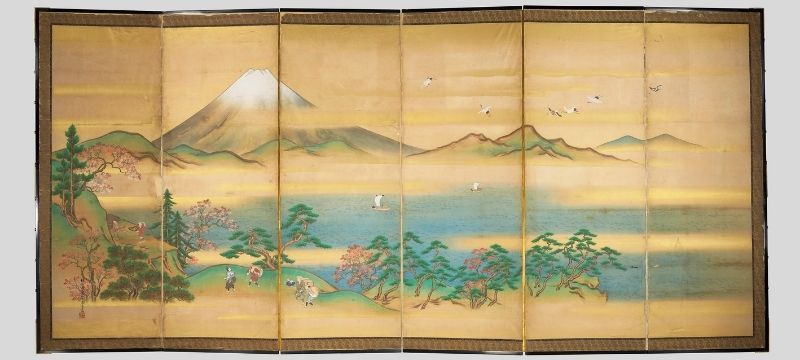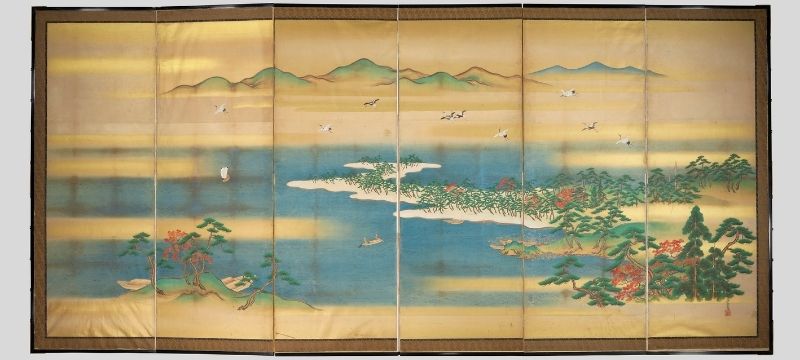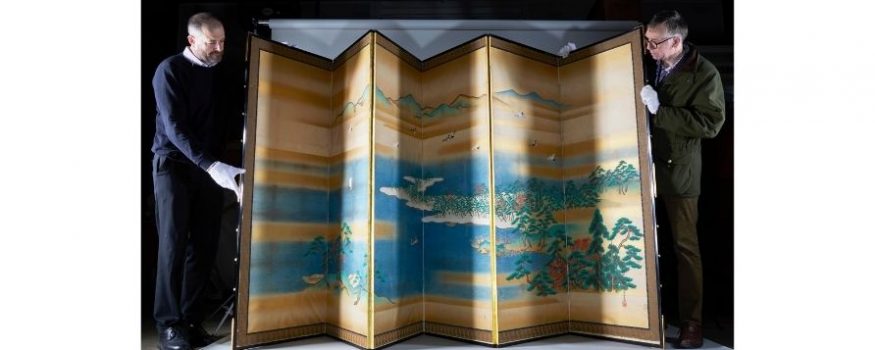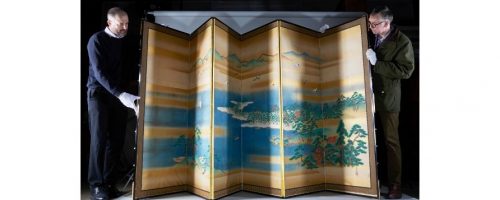A pair of folding screen paintings sent to Queen Victoria in 1860 as part of a historic diplomatic gift from the Japanese shōgun, and thought not to have survived to the present day, has been rediscovered in the Royal Collection.
Extensive conservation work following the discovery has revealed fascinating details about the screens’ history, including how they were hastily produced after a dramatic fire in Tokyo destroyed the original versions, and how wear and tear was patched up at Windsor Castle in the 19th century using fragments of Victorian railway timetables.
The screens will go on public display next month for the first time since they arrived at the British Court 162 years ago. They will form part of Japan: Courts and Culture, the first exhibition to bring together the Royal Collection’s spectacular holdings of Japanese works of art, opening at The Queen’s Gallery, Buckingham Palace on Friday 8 April.
The screen paintings depict the changing seasons in exquisite detail and formed part of the first diplomatic gift between Japan and Britain in almost 250 years. They were sent by Shōgun Tokugawa Iemochi shortly after Japan’s dramatic reopening to the West, following more than two centuries of deliberate isolation. The lavish gift marked a landmark treaty that reopened seven Japanese ports and cities to British trade and allowed a British diplomate to reside in Japan for the first time.

Folding screen paintings were an ideal vehicle to showcase the painting skills of the finest court artists of the day. Also included in the gift were a set of lacquer furniture, spears inlaid with glittering mother of pearl, and swords by leading court swordsmiths, all of which will be on display in Japan: Courts and Culture.
Eight pairs of screen paintings were sent to Queen Victoria as part of the gift, but none were thought to have survived to the present day. However, research for the exhibition by Royal Collection Trust curators raised the possibility that some might still exist in the Royal Collection. In 2017, Dr Rosina Buckland, Curator of the Japanese Collections at the British Museum, was able to translate the artist’s signatures on the two screens in question. The signatures, and further research by Royal Collection Trust curators to compare the screen paintings with those received by other European monarchs at this time, revealed that they were the work of Itaya Hiroharu, one of the artists likely to have worked on the gifts for Queen Victoria. Sometime after their arrival in Britain, the screen paintings had simply been catalogued as Japanese works by an unidentified artist, and their link to the gift from Shōgun Iemochi – and so an understanding of their historical significance – had been lost.

Rachel Peat, curator of the Japan: Courts and Culture exhibition, said, “After decades of believing these important gifts were lost, this rediscovery is extraordinarily significant. The screen paintings marked a new era of diplomatic engagement between Japan and Britain and brought the vivid beauty of Japan’s changing seasons right to the heart of the British Court. I’m delighted that visitors will see them on display for the first time, just as they might first have been admired by Queen Victoria.”
Japan: Courts and Culture explores the diplomatic, artistic and cultural exchanges between Britain and Japan over more than 350 years, from first encounters under James I to the modern partnership of Queen Elizabeth II’s reign. This royal story, never before told in a dedicated exhibition, is explored through rare surviving examples of unparalleled Japanese craftsmanship, including samurai armour, weaponry, porcelain, lacquer, woodcut prints, delicate fans and embroidered screens.
The exhibition will be held at The Queen’s Gallery, Buckingham Palace from 8 April 2022 – 26 February 2023. For more information please visit www.rct.uk.










